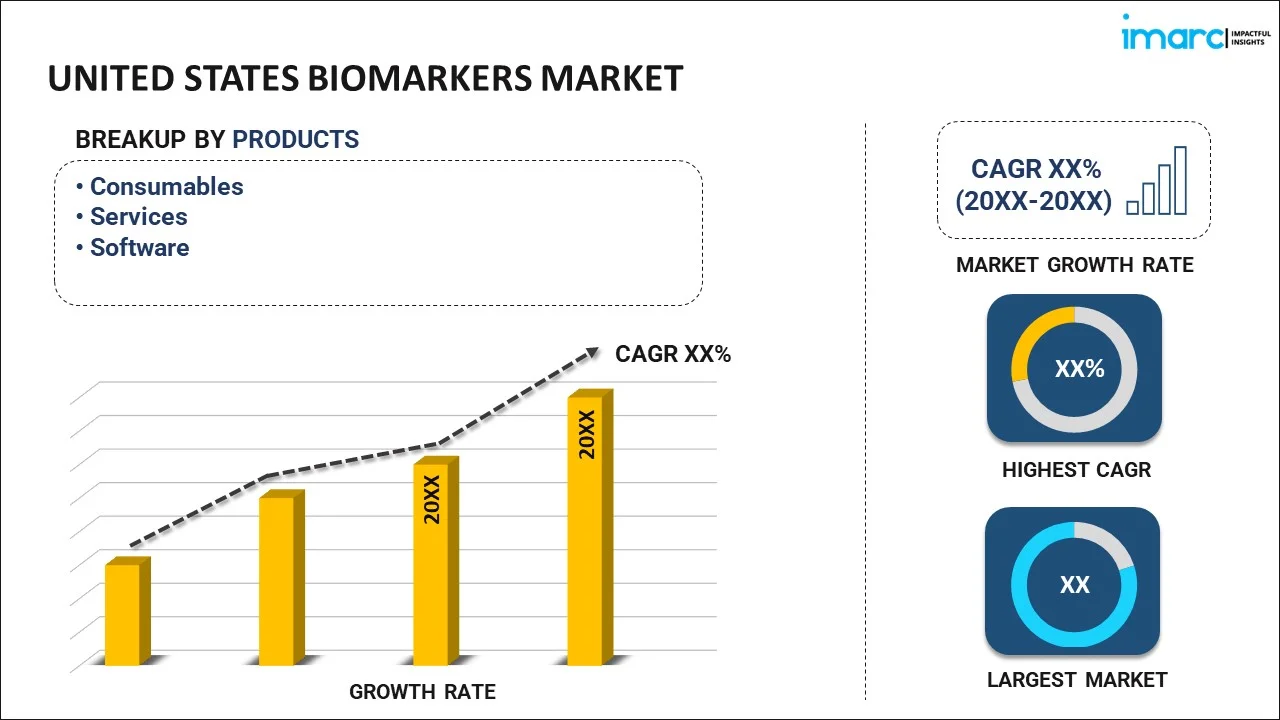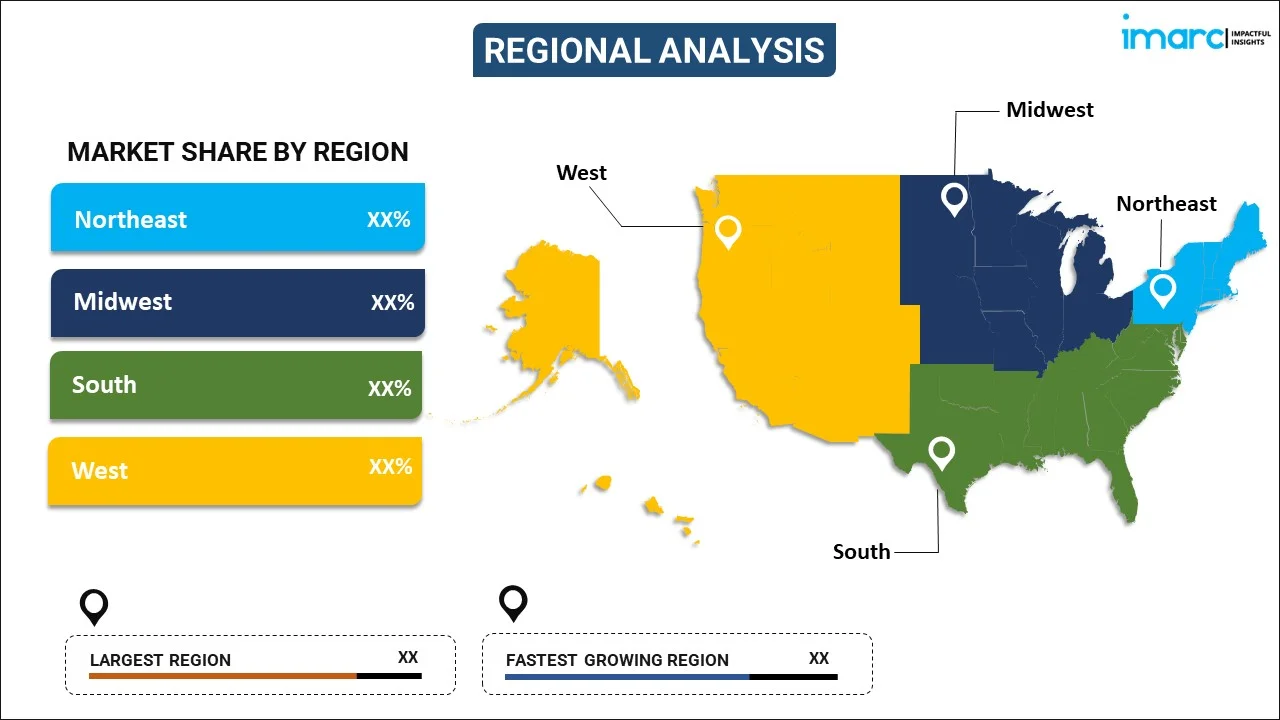
United States Biomarkers Market Report by Product (Consumables, Services, Software), Type (Efficacy Biomarkers, Safety Biomarkers, Validation Biomarkers), Disease (Cancer, Cardiovascular Disorders, Neurological Disorders, Immunological Disorders, Renal Disorders, and Others), Application (Diagnostics, Drug Discovery and Development, Personalized Medicine, and Others), End User (Pharmaceutical and Biotechnology Companies, Diagnostic and Research Laboratories, Hospitals and Specialty Clinics, and Others), and Region 2025-2033
Market Overview:
United States biomarkers market size is projected to exhibit a growth rate (CAGR) of 12.6% during 2025-2033. The increasing prevalence of chronic diseases, emphasis on personalized medicine, aging population, rising awareness of preventive healthcare, collaborative research efforts, technological advancements, and supportive regulatory environment represent some of the key factors driving the market.
|
Report Attribute
|
Key Statistics
|
|---|---|
|
Base Year
|
2024 |
|
Forecast Years
|
2025-2033 |
|
Historical Years
|
2019-2024
|
| Market Growth Rate (2025-2033) | 12.6% |
Biomarkers are measurable and quantifiable indicators that serve as biological signals within the body, providing valuable information about various physiological or pathological processes. These molecular, genetic, or cellular markers are often detectable in blood, tissues, or other bodily fluids and play a crucial role in diagnosing, monitoring, and predicting the progression of diseases. Biomarkers can encompass a diverse range of substances, including proteins, deoxyribonucleic acid (DNA), ribonucleic acid (RNA), hormones, metabolites, and cellular structures. Their significance lies in their ability to reflect normal biological processes or indicate abnormalities associated with specific conditions, such as cancer, cardiovascular diseases (CVD), or neurological disorders. Biomarkers are integral to personalized medicine, guiding treatment decisions by tailoring therapeutic approaches to individual patient characteristics. Additionally, they play a pivotal role in drug development and clinical trials, facilitating the identification of suitable participants, monitoring treatment efficacy, and predicting potential adverse effects. The exploration and discovery of novel biomarkers continue to drive advancements in diagnostics, prognostics, and therapeutic interventions, making them indispensable tools in modern healthcare for precision medicine and improved patient outcomes.
United States Biomarkers Market Trends:
The increasing prevalence of chronic diseases, such as cancer, CVDs, and diabetes in the United States is primarily fueling the demand for advanced diagnostic tools, such as biomarkers for early detection and disease monitoring. In confluence with this, the rising emphasis on personalized medicine and targeted therapies has heightened the significance of biomarkers in tailoring treatment plans to individual patients, strengthening the market growth. Moreover, the aging population in the country has led to a surge in age-related diseases, necessitating the development of biomarkers for accurate diagnosis and prognostication, thereby creating a favorable outlook for market expansion. In line with this, the escalating awareness and adoption of preventive healthcare measures among the population have spurred the demand for biomarkers for risk assessment and disease prevention, providing an impetus to the market growth. Concurrently, extensive collaborative efforts between pharmaceutical companies and diagnostic laboratories to expedite drug development processes and enhance clinical trial outcomes have intensified the integration of biomarkers in research and development (R&D) pipelines, aiding in market expansion. In addition to this, the increasing investment in R&D activities, both by public and private entities, has propelled the discovery and validation of novel biomarkers, thereby contributing to the market growth. Furthermore, ongoing advancements in technology, such as genomics and proteomics, have enabled the identification of a broader spectrum of biomarkers, enhancing the precision and reliability of diagnostic and prognostic applications, which, in turn, is driving market expansion. Apart from this, the supportive regulatory environment, characterized by streamlined approval processes for biomarker-based diagnostics, is acting as another significant growth-inducing factor.
United States Biomarkers Market Segmentation:
IMARC Group provides an analysis of the key trends in each segment of the market, along with forecasts at the country level for 2025-2033. Our report has categorized the market based on product, type, disease, application, and end user.
Product Insights:

- Consumables
- Services
- Software
The report has provided a detailed breakup and analysis of the market based on the product. This includes consumables, services, and software.
Type Insights:
- Efficacy Biomarkers
- Safety Biomarkers
- Validation Biomarkers
A detailed breakup and analysis of the market based on the type have also been provided in the report. This includes efficacy biomarkers, safety biomarkers, and validation biomarkers.
Disease Insights:
- Cancer
- Cardiovascular Disorders
- Neurological Disorders
- Immunological Disorders
- Renal Disorders
- Others
The report has provided a detailed breakup and analysis of the market based on the disease. This includes cancer, cardiovascular disorders, neurological disorders, immunological disorders, renal disorders, and others.
Application Insights:
- Diagnostics
- Drug Discovery and Development
- Personalized Medicine
- Others
A detailed breakup and analysis of the market based on the application have also been provided in the report. This includes diagnostics, drug discovery and development, personalized medicine, and others.
End User Insights:
- Pharmaceutical and Biotechnology Companies
- Diagnostic and Research Laboratories
- Hospitals and Specialty Clinics
- Others
The report has provided a detailed breakup and analysis of the market based on the end user. This includes pharmaceutical and biotechnology companies, diagnostic and research laboratories, hospitals and specialty clinics, and others.
Regional Insights:

- Northeast
- Midwest
- South
- West
The report has also provided a comprehensive analysis of all the major regional markets, which include Northeast, Midwest, South, and West.
Competitive Landscape:
The market research report has also provided a comprehensive analysis of the competitive landscape in the market. Competitive analysis such as market structure, key player positioning, top winning strategies, competitive dashboard, and company evaluation quadrant has been covered in the report. Also, detailed profiles of all major companies have been provided.
United States Biomarkers Market Report Coverage:
| Report Features | Details |
|---|---|
| Base Year of the Analysis | 2024 |
| Historical Period | 2019-2024 |
| Forecast Period | 2025-2033 |
| Units | Million USD |
| Scope of the Report | Exploration of Historical Trends and Market Outlook, Industry Catalysts and Challenges, Segment-Wise Historical and Future Market Assessment:
|
| Products Covered | Consumables, Services, Software |
| Types Covered | Efficacy Biomarkers, Safety Biomarkers, Validation Biomarkers |
| Diseases Covered | Cancer, Cardiovascular Disorders, Neurological Disorders, Immunological Disorders, Renal Disorders, Others |
| Applications Covered | Diagnostics, Drug Discovery and Development, Personalized Medicine, Others |
| End Users Covered | Pharmaceutical and Biotechnology Companies, Diagnostic and Research Laboratories, Hospitals and Specialty Clinics, Others |
| Regions Covered | Northeast, Midwest, South, West |
| Customization Scope | 10% Free Customization |
| Post-Sale Analyst Support | 10-12 Weeks |
| Delivery Format | PDF and Excel through Email (We can also provide the editable version of the report in PPT/Word format on special request) |
Key Questions Answered in This Report:
- How has the United States biomarkers market performed so far and how will it perform in the coming years?
- What has been the impact of COVID-19 on the United States biomarkers market?
- What is the breakup of the United States biomarkers market on the basis of product?
- What is the breakup of the United States biomarkers market on the basis of type?
- What is the breakup of the United States biomarkers market on the basis of disease?
- What is the breakup of the United States biomarkers market on the basis of application?
- What is the breakup of the United States biomarkers market on the basis of end user?
- What are the various stages in the value chain of the United States biomarkers market?
- What are the key driving factors and challenges in the United States biomarkers?
- What is the structure of the United States biomarkers market and who are the key players?
- What is the degree of competition in the United States biomarkers market?
Key Benefits for Stakeholders:
- IMARC’s industry report offers a comprehensive quantitative analysis of various market segments, historical and current market trends, market forecasts, and dynamics of the United States biomarkers market from 2019-2033.
- The research report provides the latest information on the market drivers, challenges, and opportunities in the United States biomarkers market.
- Porter's five forces analysis assist stakeholders in assessing the impact of new entrants, competitive rivalry, supplier power, buyer power, and the threat of substitution. It helps stakeholders to analyze the level of competition within the United States biomarkers industry and its attractiveness.
- Competitive landscape allows stakeholders to understand their competitive environment and provides an insight into the current positions of key players in the market.
Need more help?
- Speak to our experienced analysts for insights on the current market scenarios.
- Include additional segments and countries to customize the report as per your requirement.
- Gain an unparalleled competitive advantage in your domain by understanding how to utilize the report and positively impacting your operations and revenue.
- For further assistance, please connect with our analysts.
 Inquire Before Buying
Inquire Before Buying
 Speak to an Analyst
Speak to an Analyst
 Request Brochure
Request Brochure
 Request Customization
Request Customization




.webp)




.webp)












